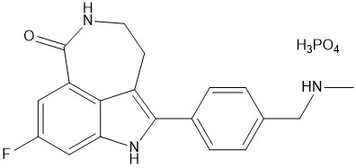Rucaparib phosphate | PARP1 inhibitor
NMR (Conforms)

Available Options
| Size: | Price | Quantity | |
|---|---|---|---|
| 5 mg | $70.00 | ||
| 25 mg | $280.00 |
Rucaparib phosphate (459868-92-9) is a potent (Ki<5 nM) PARP1 inhibitor.1 Cytotoxic to human cancer cells or xenograft tumors with mutated or epigenetically silenced BRCA1/2.2 Demonstrates antiproliferative effects in 26 out of 39 ovarian cancer cell lines.3 Synergizes with other anticancer agents such as topotecan, carboplatin, doxorubicin, paclitaxel,3 and temozolomide.4 Ameliorates the cardiotoxicity of doxorubicin.5 Recently approved for human use by the FDA.
References/Citations:
1) Thomas et al. (2007), Preclinical selection of a n novel poly(ADP-ribose) polymerase inhibitor for clinical trial; Mol. Cancer Ther., 6 945
2) Drew et al. (2011), Therapeutic potential of poly(ADP-ribose) polymerase inhibitor AG014699 in human cancers with mutated or methylated BRCA1 or BRCA2; J. Natl. Cancer Inst., 103 334
3) Ihnen et al. (2013), Therapeutic potential of the poly(ADP-ribose) polymerase inhibitor rucaparib for the treatment of sporadic human ovarian cancer; Mol. Cancer Ther., 12 1002
4) Plummer et al. (2013), A phase II study of the potent PARP inhibitor, Rucaparib (PF-01367338, AG014699), with temozolomide in patients with metastatic melanoma demonstrating evidence of chemopotentiation; Cancer Chemother. Pharmacol., 71 1191
5) Ali et al. (2011), The clinically active PARP inhibitor AG014699 ameliorates cardiotoxicity but does not enhance the efficacy of doxorubicin, despite improving tumor perfusion and radiation response in mice; Mol. Cancer Ther., 10 2320
NMR (Conforms)
Safety Data Sheet:
Product Data Sheet:
Materials provided by Focus Biomolecules are for laboratory research use only and are not intended for human or veterinary applications. Please note that we do not sell to individuals and that all orders placed by non-research organizations will incur a $20 restocking/refund fee
Rucaparib phosphate (459868-92-9) is a potent (Ki<5 nM) PARP1 inhibitor.1 Cytotoxic to human cancer cells or xenograft tumors with mutated or epigenetically silenced BRCA1/2.2 Demonstrates antiproliferative effects in 26 out of 39 ovarian cancer cell lines.3 Synergizes with other anticancer agents such as topotecan, carboplatin, doxorubicin, paclitaxel,3 and temozolomide.4 Ameliorates the cardiotoxicity of doxorubicin.5 Recently approved for human use by the FDA.
References/Citations:
1) Thomas et al. (2007), Preclinical selection of a n novel poly(ADP-ribose) polymerase inhibitor for clinical trial; Mol. Cancer Ther., 6 945
2) Drew et al. (2011), Therapeutic potential of poly(ADP-ribose) polymerase inhibitor AG014699 in human cancers with mutated or methylated BRCA1 or BRCA2; J. Natl. Cancer Inst., 103 334
3) Ihnen et al. (2013), Therapeutic potential of the poly(ADP-ribose) polymerase inhibitor rucaparib for the treatment of sporadic human ovarian cancer; Mol. Cancer Ther., 12 1002
4) Plummer et al. (2013), A phase II study of the potent PARP inhibitor, Rucaparib (PF-01367338, AG014699), with temozolomide in patients with metastatic melanoma demonstrating evidence of chemopotentiation; Cancer Chemother. Pharmacol., 71 1191
5) Ali et al. (2011), The clinically active PARP inhibitor AG014699 ameliorates cardiotoxicity but does not enhance the efficacy of doxorubicin, despite improving tumor perfusion and radiation response in mice; Mol. Cancer Ther., 10 2320
Related PARP Products
Download
Calculate the molar concentration, mass or volume in a solution.
Concentration × Volume × Molecular Weight = Mass
Focus Biomolecules • Plymouth Meeting, PA USA • 1-855-FOCUS21
Focus Biomolecules
Plymouth Meeting, PA USA
1-855-FOCUS21
Website Created by Advanta Advertising LLC.

